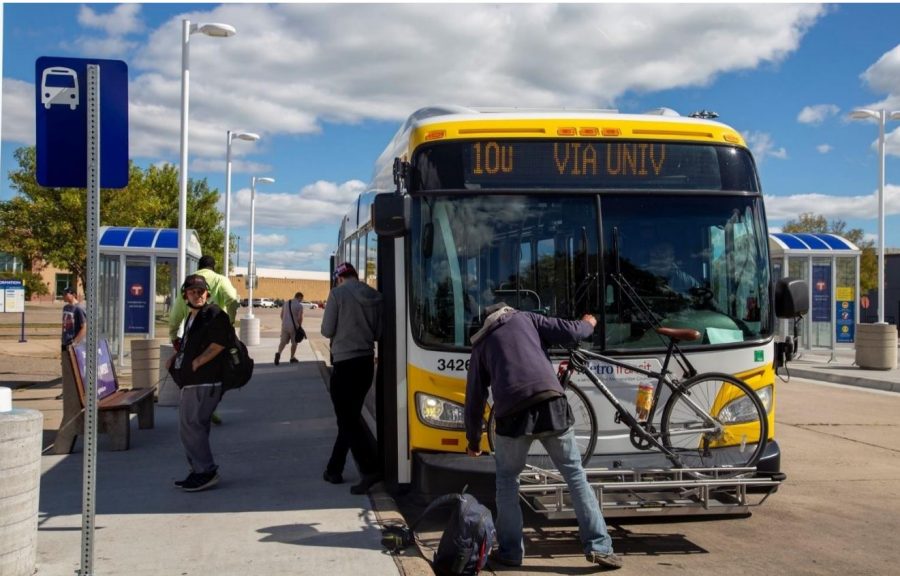Metro Transit is moving forward with plans to upgrade and replace large parts of one of its most popular routes with a Bus Rapid Transit (BRT) line that will run from downtown Minneapolis to Blaine.
The F line will replace parts of Metro Transit’s Route 10, which runs along Central Avenue near Marcy-Holmes Northeast, and will stop at University Avenue, First Avenue and St. Anthony intersections. The project, when finished, will be the sixth line in Metro Transit’s plan to construct a network of eight BRT lines by 2030.
The F line aims to provide faster, more reliable service for riders on what is currently one of the slowest bus routes. The route is scheduled to begin service in 2026.
The F line will have 32 stations along the 13-mile route, each of which will be upgraded with heated shelters, real-time arrival information, lighting, security cameras and textured platform edges.
The planned BRT line will have stops near Nicollet Mall, St. Anthony and Northtown Mall in Blaine. Jake Knight, senior planner of Metro Transit’s BRT program, said he hopes the F line will be among many BRT lines offering improved services.
“We know that folks who are riding Route 10 are using it for a variety of different reasons, not just commuting to work or commuting to school,” Knight said. “We’re trying to create a holistic network that folks can rely on every day, where the service is frequent and reliable.”
Metro Transit prioritized Route 10 as part of its BRT program to promote equity and reduce racial disparities in public transportation accessibility, Knight said.
More than half of Route 10’s riders are people of color. According to Knight, one-fifth of riders identify as having a disability and 80% identify as having less than $60,000 in annual income.
Metro Transit is currently reviewing public comments and will release an updated plan for the F line in the spring, after which they will seek additional public comment. The Metropolitan Council will vote to approve a final plan in the summer.
One major change riders will experience on the F line is about double the distance between stops, Knight said. Metro Transit planned the F line stops about a half mile apart from each other to lessen vehicle congestion and decrease transit time for riders.
“We have this balancing act of providing a stop every block … and on the other side is the desire for faster service that gets you from point A to point B more quickly,” Knight said. “Maybe your two-minute walk turns into a five-minute walk; that’s certainly a trade-off.”
Bus stop accessibility is something many riders are unwilling to compromise on.
Barbara Camm, co-founder of Preserve Historic Dinkytown, a local nonprofit working to maintain the neighborhood’s cultural history, said she fears plans for stations placed further apart will make the route inaccessible for those with mobility issues.
“I know [Metro Transit] has accommodations for people who are handicapped,” Camm said. “But still, if you have to do a lot of walking in between stops, that’s going to be a problem.”
The 60-foot BRT buses will come equipped with low floors and accessibility ramps and should run every 10 minutes during the day and most of the evening, according to Knight. However, Metro Transit’s current operator shortage has raised concerns about whether Metro Transit will have enough bus operators to maintain a 10-minute pace.
Chris Lautenschlager, executive director of the Marcy-Holmes Neighborhood Association, said in the past, he’s had to wait for Metro Transit buses that arrived 45 minutes late with no way of knowing when a bus would arrive.
“People in our community tend to be coming to and fro quite often at any time of day, and we want them to be able to use reliable buses,” Lautenschlager said. “It just promotes confidence in the entire system.”
Lautenschlager said he hopes the F line’s improvements to Route 10 will encourage more people to consider public transportation. If so, he said fewer cars will make roads safer for pedestrians as well.
“That was always the goal, we don’t need to park because there is a high-frequency bus,” Lautenschlager said. “Anything that we can do to get rid of cars to promote biking and walking and doing it safely is incredibly important to us. It’s our number one priority.”






















